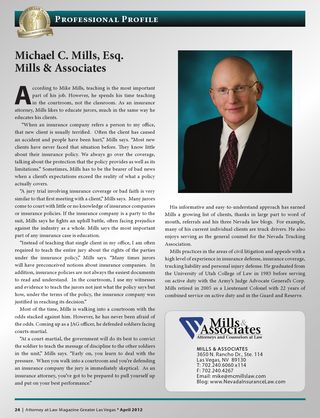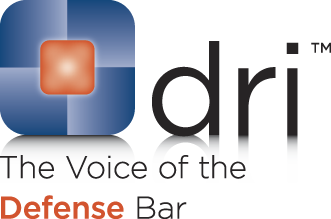This is a previously published Mills & Associates Newsletter.
For additional information on this or other Nevada Insurance Law topics, please e-mail Mr. Mills at mike@mcmillslaw.com or phone (702) 240-6060.
The Eighth Judicial District Court recently implemented the Nevada Short Trial Program. This article will outline the Short Trial Program. It will discuss what types of cases may be best suited for the Short Trial Program. It will also consider some of the risks of submitting ill-suited cases to the Program. By familiarizing yourself with the Short Trial rules, you will be able to avoid the pitfalls and maximize the benefits of the new program. If you are interested, the Short Trial Rules are found in the Nevada Supreme Court Rules, Part V, Rules Governing Practice in certain actions In The District Courts, Subpart B, Nevada Short Trial Rules.
I. To Arbitrate Or Not To Arbitrate
Participation in Short Trial is fully voluntary. Rule 1. A Stipulation and Order must be filed with the court to get into the Program. Parties can enter the Short Trial Program before or after arbitration. With the costs of arbitration going up to $100/hour with a maximum of $1,000, opting out of arbitration may not be a bad option. Keep in mind that a Short Trial will be scheduled to begin no more than 180 days from when the case enters the program. (120 days if arbitration has been completed). Rule 2. Therefore, discovery will need to be carefully planned and completed. A case requiring substantial or complex discovery will not be a good fit with the Short Trial Program.
II. Here Comes The Judge (Pro Tempore)
The Short Trial Program anticipates that judges pro tempore will be used in lieu of District Court judges. Rule 17. These judges pro tempore will play a play a key role in processing the case from beginning to end. In addition to presiding at trial, the judge pro tempore will rule on discovery disputes, preside at the telephonic pretrial conference, rule on motions in limine, settle jury instructions and decide post-trial motions. Rules 11-14. Because the judge pro tempore will be so closely involved in all aspects of the case, it will be important to have a judge with experience. The court is in the process of qualifying a list of judges pro tempore. Rule 17. The parties can select from the list of qualified judges or a panel of three will be chosen at random with each party striking one and the judge being chosen from the remainder. Rule 17. Similar to the arbitration program, the parties will initially share the cost of the judge pro tempore, $150/hour up to a maximum of $1,500.00. Rule 18.
III. Countdown To Trial
The timeline leading to trial must be closely observed. Each side must submit its evidentiary booklet at least seven days prior to trial along with its Pretrial Memorandum. Rules 10 & 14. All objections to the other side’s evidence must be raised at least five days prior to trial. Rule 11. Normally, certified documentary evidence will be admissible without the need for testimony from a custodian of records. The judge pro tempore will rule on admissibility issues at the Pretrial Conference, which is held at least three days before trial. Rule 13. Trial continuance will probably be frowned upon because courtroom space will be at a premium. However, failure to grant a properly requested continuance could result in a verdict being vacated. N.R.S. § 38.145.
IV. The Anatomy Of A Short Trial
Trials take place at a courtroom supplied by the court. Rule 20. On the day of trial, the Judicial Executive Assistant will provide twelve potential jurors. Rule 21. Voir dire is allowed (30 minutes reserved to the judge and 15 minutes to each attorney). Rule 5. After challenges for cause, each side has two peremptory challenges. A jury of four is then seated with no provision for an alternate.
Each side gets three hours to present their case. The clock runs against a party during its opening and closing statements and its direct or cross examination. Rule 6. All Plaintiffs and all Defendants are treated collectively as one. So parties will need to be careful about placing cases in the program cases that are overly complex or that involve too many parties (unless the parties stipulate to allow for more trial time). Depositions, interrogatories and admissions can be read directly to the jury avoiding the delay caused by formal publication. Rule 7. Otherwise, the rules of evidence apply. Rule 3.
V. The Verdict
Jury Instructions are submitted with the Pretrial Memorandum. Rules 12 & 13. Three of the four jurors must agree on a verdict. Rule 9. Although the jury will not know it, the judgment (exclusive of fees, costs and interest) will not exceed the cap of $40,000.00 per plaintiff. Rule 9. Parties may stipulate to a different cap. The Verdict is delivered to the clerk and judgment can be entered directly on the Verdict.
VI. Post-Trial Motions
The judge pro tempore will decide post trial motions for costs, interest and attorney’s fees on briefs without oral argument. The offer of judgment rules apply. Rule 15. Although the costs of the judge pro tempore are initially split equally between the parties, those costs can be retaxed. Rules 18 & 19. Appeals are not authorized. Judicial review of a Short Trial Verdict is limited to remedies found in NRS § 38.115 and NRS § 38.145. (Correcting or Vacating the Verdict). These sections allow only limited review in very exceptional circumstances. Rule 16.
VII. Conclusion
The Short Trial Program can bring benefits to Plaintiffs, Defendants and the Court. Trials in District Court are sometimes slow in arriving and can be costly and time consuming. The Short Trials program should go a long way to overcome these disadvantages. Furthermore, unlike the mandatory arbitration program, Short Trial decisions cannot be “de novoed” and post- trial reviews will be limited. The Short Trial Rules do not currently provide a means to exit from the Short Trial Program once a party has opted in. Therefore, careful selection of cases will be the key to effectively using the Short Trial Program. Cases best suited to the program cannot be overly complex and cannot require extensive discovery. There cannot be too many parties because of time limits in presenting the case to the jury. Cases of a value in excess of $40,000 may not be well suited to the program. If timelines are not strictly followed, important evidence may not be admitted. Even with these limitations, it is expected that many appropriately selected cases will be successfully presented and resolved under the Short Trial Program.



